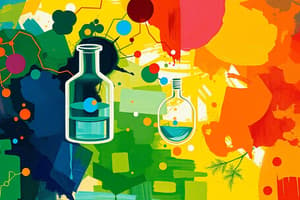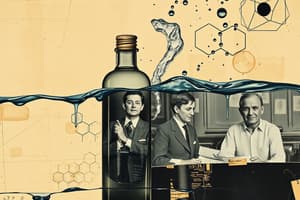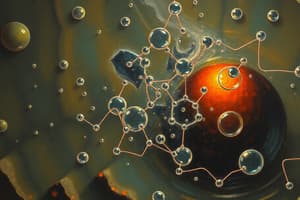Podcast
Questions and Answers
Which property of water allows it to absorb a significant amount of energy before increasing in temperature?
Which property of water allows it to absorb a significant amount of energy before increasing in temperature?
- Being a solvent
- Expanding upon freezing
- Cohesion
- Moderating temperature (correct)
Solid water (ice) is denser than liquid water.
Solid water (ice) is denser than liquid water.
False (B)
What is the pH range that blood must be maintained within?
What is the pH range that blood must be maintained within?
7.35 to 7.45
Water is a ______ molecule, allowing it to dissolve polar and charged substances.
Water is a ______ molecule, allowing it to dissolve polar and charged substances.
Match the following terms with their definitions:
Match the following terms with their definitions:
What is the primary reason freshwater organisms can survive in icy conditions during winter?
What is the primary reason freshwater organisms can survive in icy conditions during winter?
Hydrogen bonds in water molecules are essential for life.
Hydrogen bonds in water molecules are essential for life.
What do we call the phenomenon where water molecules stick to one another?
What do we call the phenomenon where water molecules stick to one another?
Which type of fats are primarily made up of saturated fatty acids?
Which type of fats are primarily made up of saturated fatty acids?
Phospholipids are completely hydrophobic molecules.
Phospholipids are completely hydrophobic molecules.
What is the main structural feature of steroids?
What is the main structural feature of steroids?
Sterols are steroids with at least one _______ group.
Sterols are steroids with at least one _______ group.
Match the types of fats with their examples:
Match the types of fats with their examples:
Which of the following is NOT a type of fatty acid?
Which of the following is NOT a type of fatty acid?
Fat-soluble vitamins include vitamins A and C.
Fat-soluble vitamins include vitamins A and C.
What are the monomers of proteins called?
What are the monomers of proteins called?
Eicosanoids are _______ carbon compounds.
Eicosanoids are _______ carbon compounds.
Which is a function of cholesterol in biological membranes?
Which is a function of cholesterol in biological membranes?
What type of bond is formed between amino acids during dehydration synthesis?
What type of bond is formed between amino acids during dehydration synthesis?
The primary structure of proteins is their three-dimensional shape.
The primary structure of proteins is their three-dimensional shape.
What do we call the structure that results from multiple polypeptide chains in a protein?
What do we call the structure that results from multiple polypeptide chains in a protein?
Fibrous proteins, such as __________, are water-insoluble and form long parallel bundles.
Fibrous proteins, such as __________, are water-insoluble and form long parallel bundles.
Which type of protein is characterized as being round or 'blob-like' and water-soluble?
Which type of protein is characterized as being round or 'blob-like' and water-soluble?
Hydrogen bonds stabilize the tertiary structure of proteins.
Hydrogen bonds stabilize the tertiary structure of proteins.
What determines the primary structure of a protein?
What determines the primary structure of a protein?
When proteins lose their structure and become biologically inactive, they are said to be __________.
When proteins lose their structure and become biologically inactive, they are said to be __________.
What is the main function of ATP in cells?
What is the main function of ATP in cells?
Match the following protein structures with their descriptions:
Match the following protein structures with their descriptions:
ATP is produced by endergonic cellular reactions.
ATP is produced by endergonic cellular reactions.
Which type of bond is formed between sulfhydryl groups in proteins?
Which type of bond is formed between sulfhydryl groups in proteins?
What is released during the hydrolysis of ATP?
What is released during the hydrolysis of ATP?
ATP is synthesized by ATP extbf{______} during aerobic cellular respiration.
ATP is synthesized by ATP extbf{______} during aerobic cellular respiration.
Match the biological molecules with their correct class:
Match the biological molecules with their correct class:
Which of the following correctly describes the structure of DNA?
Which of the following correctly describes the structure of DNA?
RNA contains thymine (T) as one of its nitrogenous bases.
RNA contains thymine (T) as one of its nitrogenous bases.
What are the monomers of nucleic acids called?
What are the monomers of nucleic acids called?
In the DNA double helix, the backbone consists of phosphate groups and __________.
In the DNA double helix, the backbone consists of phosphate groups and __________.
Match the type of RNA with its primary function:
Match the type of RNA with its primary function:
What event occurs when DNA is being copied?
What event occurs when DNA is being copied?
Genes are made of RNA.
Genes are made of RNA.
What are the two types of nucleic acids mentioned?
What are the two types of nucleic acids mentioned?
In DNA, adenine pairs with __________.
In DNA, adenine pairs with __________.
What is a mutation?
What is a mutation?
What type of organic molecule is specifically made up of only carbon and hydrogen?
What type of organic molecule is specifically made up of only carbon and hydrogen?
Monosaccharides are the monomers of proteins.
Monosaccharides are the monomers of proteins.
What are functional groups?
What are functional groups?
Carbohydrates, lipids, proteins, and nucleic acids are the four classes of biological __________.
Carbohydrates, lipids, proteins, and nucleic acids are the four classes of biological __________.
Match the types of biological macromolecules with their respective examples:
Match the types of biological macromolecules with their respective examples:
What is the primary outcome of different chemical structures in organic molecules?
What is the primary outcome of different chemical structures in organic molecules?
Polymers are made by linking monomers through dehydration synthesis.
Polymers are made by linking monomers through dehydration synthesis.
Steroid hormones are modified structures based on __________.
Steroid hormones are modified structures based on __________.
What type of fats includes olive oil and avocado oil?
What type of fats includes olive oil and avocado oil?
Saturated fats contain mostly unsaturated fatty acids.
Saturated fats contain mostly unsaturated fatty acids.
What is the main function of cholesterol in biological membranes?
What is the main function of cholesterol in biological membranes?
Phospholipids consist of a glycerol backbone covalently linked to two fatty acids and a __________ group.
Phospholipids consist of a glycerol backbone covalently linked to two fatty acids and a __________ group.
Match the following types of lipids with their characteristics:
Match the following types of lipids with their characteristics:
Which type of fatty acids are found in fatty fish oils?
Which type of fatty acids are found in fatty fish oils?
Eicosanoids are 10-carbon compounds.
Eicosanoids are 10-carbon compounds.
What are the monomers of proteins called?
What are the monomers of proteins called?
Sterols are defined as steroids with at least one __________ group.
Sterols are defined as steroids with at least one __________ group.
Which of the following is NOT a characteristic of proteins?
Which of the following is NOT a characteristic of proteins?
What is the bond formed between amino acids called?
What is the bond formed between amino acids called?
Only large proteins can consist of multiple polypeptide chains.
Only large proteins can consist of multiple polypeptide chains.
What type of interactions are important drivers of protein folding?
What type of interactions are important drivers of protein folding?
The _____ structure of proteins is the arrangement of polypeptide chains in multi-peptide proteins.
The _____ structure of proteins is the arrangement of polypeptide chains in multi-peptide proteins.
Match the following protein structures with their characteristics:
Match the following protein structures with their characteristics:
Which type of protein is characterized by its long parallel bundles and water-insoluble nature?
Which type of protein is characterized by its long parallel bundles and water-insoluble nature?
Hydrogen bonds stabilize the secondary structure of proteins.
Hydrogen bonds stabilize the secondary structure of proteins.
What happens to proteins when they lose their structure?
What happens to proteins when they lose their structure?
The repeated folds of proteins observed in the _____ structure are stabilized by hydrogen bonds.
The repeated folds of proteins observed in the _____ structure are stabilized by hydrogen bonds.
What type of protein is round or blob-like and typically water-soluble?
What type of protein is round or blob-like and typically water-soluble?
What is the primary function of RNA in the cell?
What is the primary function of RNA in the cell?
DNA is single-stranded.
DNA is single-stranded.
What are the monomers of nucleic acids called?
What are the monomers of nucleic acids called?
In DNA, thymine pairs with ________.
In DNA, thymine pairs with ________.
Match the following types of RNA with their primary functions:
Match the following types of RNA with their primary functions:
Which sugar is found in RNA?
Which sugar is found in RNA?
The backbone of nucleic acids consists of nitrogenous bases and phosphate groups.
The backbone of nucleic acids consists of nitrogenous bases and phosphate groups.
What is the role of ATP in cellular processes?
What is the role of ATP in cellular processes?
ATP is produced by endergonic reactions.
ATP is produced by endergonic reactions.
What is a mutation?
What is a mutation?
DNA undergoes ________ to produce an identical copy.
DNA undergoes ________ to produce an identical copy.
What is released during the hydrolysis of ATP?
What is released during the hydrolysis of ATP?
ATP is synthesized by ATP __________ during aerobic cellular respiration.
ATP is synthesized by ATP __________ during aerobic cellular respiration.
Which of the following nitrogenous bases is only found in RNA?
Which of the following nitrogenous bases is only found in RNA?
Match the biological macromolecules with their classes:
Match the biological macromolecules with their classes:
Flashcards are hidden until you start studying
Study Notes
Properties of Water
- Exhibits cohesion by allowing molecules to stick together.
- Moderates temperature by absorbing significant energy before temperature changes; plays a crucial role in climate regulation.
- Expands upon freezing, causing ice to float due to the lattice structure formed by hydrogen bonds.
- Functions as a solvent, effectively dissolving polar and charged substances (hydrophilic) while not dissolving nonpolar substances (hydrophobic).
- Buffers help maintain a stable pH, essential for biological functions; blood pH is maintained between 7.35-7.45.
Organic Molecules
- Composed of matter, which is governed by chemical and physical laws.
- Saturated fats contain saturated fatty acids; unsaturated fats can be monounsaturated or polyunsaturated.
- Phospholipids have a glycerol backbone linked to two fatty acids and a phosphate group, featuring hydrophilic heads and hydrophobic tails, making them amphipathic.
- Steroids consist of four fused carbon rings; cholesterol serves as the precursor for other steroids and maintains membrane fluidity.
Proteins
- Composed of carbon, hydrogen, oxygen, and nitrogen; account for 12-18% of body mass.
- Made up of amino acids, which are the building blocks linked by peptide bonds through dehydration synthesis.
- Protein structure is organized into primary (amino acid sequence), secondary (α-helices and β-sheets stabilized by hydrogen bonds), tertiary (3D shape driven by various interactions), and quaternary (arrangement of multiple polypeptides) levels.
- Fibrous proteins are water-insoluble and form structures like hair and muscle filaments; globular proteins are water-soluble and include enzymes and antibodies.
- Denaturation results in the loss of protein structure and function, rendering proteins inactive.
Nucleic Acids
- Comprise DNA and RNA, containing carbon, hydrogen, oxygen, nitrogen, and phosphorus.
- DNA is transcribed to RNA, which is subsequently translated to proteins; genes are sections of DNA that code for proteins.
- Nucleotides are the monomers, consisting of a nitrogenous base, pentose sugar, and phosphate group.
- DNA features a double helix structure with base pairing between purines (A, G) and pyrimidines (C, T), while RNA contains uracil (U) instead of thymine (T).
- DNA replication involves creating a new double helix using one original strand as a template; mutations can occur from changes in the nucleotide sequence.
Energy Currency: ATP
- Adenosine triphosphate (ATP) is a crucial nucleotide that serves as the energy currency for cells.
- Comprises three phosphate groups bound to adenosine; energy is released upon hydrolysis of the terminal phosphate.
- ATP is generated by exergonic cellular reactions and consumed in endergonic reactions to perform work.
- ATP synthesis is catalyzed by ATP synthase during aerobic respiration.
Summary of Biological Molecules
- Four classes of biological molecules: carbohydrates, lipids, proteins, and nucleic acids.
- All classes are polymers of monomers except for lipids, which do not have a common monomer.
- The structure of biological molecules is intrinsically linked to their specific functions.
Organic Molecules
- Organic molecules primarily consist of carbon atoms.
- Carbon skeletons form the backbone, held together by covalent bonds.
- Hydrocarbons are organic molecules composed solely of carbon and hydrogen.
- Functional groups are additional atoms or molecules attached to carbon skeletons, influencing chemical properties and functions.
Biological Molecules
- Composed of complex organic compounds.
- Cells contain trillions of organic molecules organized into a limited number of structural subunits.
- Most biological molecules are polymers made from monomers.
Classes of Biological Monomers
- Four main classes include carbohydrates, lipids, proteins, and nucleic acids.
Carbohydrates
- Formed of carbon, hydrogen, and oxygen; make up 2-3% of total body mass.
- Monosaccharides (simple sugars) serve as the monomers for carbohydrates.
- Monosaccharides can link through dehydration synthesis to form more complex carbohydrates.
Lipids
- Saturated fats consist mainly of saturated fatty acids, while unsaturated fats contain mono- or polyunsaturated fatty acids.
- Monounsaturated fats include oils from olive, canola, and avocado; polyunsaturated fats include corn and fish oils.
Phospholipids
- Composed of glycerol, two fatty acids, and a phosphate group.
- Amphipathic properties stem from polar (hydrophilic) phosphate heads and nonpolar (hydrophobic) fatty acid tails.
Steroids
- Comprised of four fused carbon rings; cholesterol is a precursor for steroid synthesis.
- Cholesterol contributes to membrane fluidity and is categorized as a sterol if it has a hydroxyl group, making it slightly amphipathic.
Other Lipids
- Eicosanoids are 20-carbon compounds that include immune signaling molecules like prostaglandins.
- Fat-soluble vitamins (D, E, K) are essential in the diet.
Proteins
- Comprised of carbon, hydrogen, oxygen, and nitrogen; account for 12-18% of body mass.
- The building blocks are amino acids (20 natural types), each with a central carbon connected to an amino group, carboxyl group, and an R group that defines its properties.
- Amino acids are linked via dehydration synthesis to form peptide bonds, creating polypeptides from individual amino acids.
- Proteins can be simple (single polypeptide) or complex (multiple polypeptides).
- Protein structure levels:
- Primary: sequence of amino acids
- Secondary: α-helices and β-sheets stabilized by hydrogen bonds
- Tertiary: 3D shape influenced by various bonds and interactions
- Quaternary: arrangement of multiple polypeptide chains.
Types of Proteins
- Fibrous proteins (e.g., keratin) are insoluble and form structures like hair.
- Globular proteins (e.g., antibodies) are water-soluble and involved in metabolic functions.
- Denatured proteins lose their structure and biological activity.
Nucleic Acids
- Include DNA and RNA, made of carbon, hydrogen, oxygen, nitrogen, and phosphorus.
- DNA contains genes, sequences essential for coding specific proteins.
- DNA transcription converts its information into RNA, which is then translated into proteins by ribosomes.
Nucleotide Structure
- Monomers are nucleotides composed of a nitrogenous base, pentose sugar, and phosphate group.
- DNA and RNA base pairing:
- DNA: adenine (A), guanine (G), cytosine (C), thymine (T)
- RNA: adenine (A), guanine (G), cytosine (C), uracil (U)
- The DNA structure is a double helix, while RNA is single-stranded.
ATP (Adenosine Triphosphate)
- ATP serves as the energy currency of cells, composed of adenine, ribose, and three phosphate groups.
- Energy is released during hydrolysis of ATP, particularly when the terminal phosphate group is removed.
- ATP is regenerated via ATP synthase during aerobic respiration.
Summary
- Biological molecules, including carbohydrates, lipids, proteins, and nucleic acids, possess diverse structures linked directly to their functions, with lipids being the exception as they are not formed from polymerized monomers.
Studying That Suits You
Use AI to generate personalized quizzes and flashcards to suit your learning preferences.




